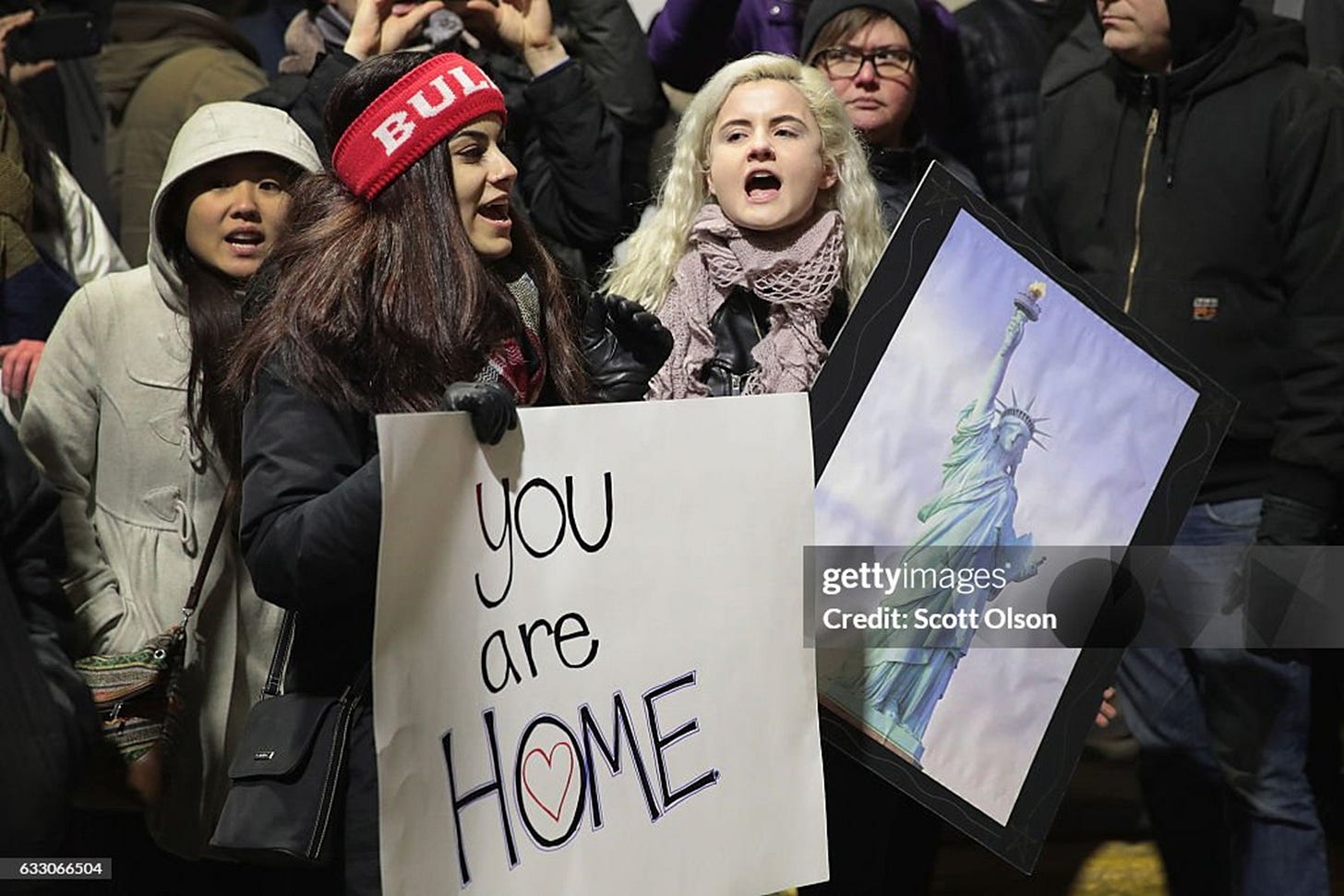Other articles on Trump’s policies: Big Beautiful Bill and Budget Deficits, Implications of Market Decline, Fed Independence, Tariffs Part 1, and Tariffs Part 2.
Demonstrators protest President Donald Trump's executive order, which imposes a freeze on admitting refugees into the United States and a ban on travel from seven Muslim-majority countries at the international terminal at O'Hare Airport on January 29, 2017, in Chicago.
In January 2017, Eman Ali, a 12-year-old Yemeni girl, found herself stranded in Djibouti, East Africa, despite having secured an immigrant visa to join her family in Los Banos, California. She was barred from boarding her flight due to President Trump's executive order banning immigration from seven Muslim-majority countries, including Yemen. This abrupt policy change left Eman isolated and separated from her loved ones, highlighting the immediate and personal consequences of such sweeping immigration decisions. Immigrants already make up one in six American workers and start roughly one in four new U.S. businesses, forming companies at nearly twice the rate of native-born Americans—yet the ban casts Laiba’s family as a threat. Critics rightly call this policy “a transparent attempt to scapegoat immigrants”, labeling it “reckless” and “racist.” Experts say that such sweeping bans “do nothing to make us safer or more prosperous”. Eman’s story is a reminder that these fear-driven policies betray America’s values of openness and fairness, punishing the very people who strengthen our nation.
On June 4, 2025, President Donald Trump signed an executive order barring nationals of 12 countries from entering the United States and imposing partial restrictions on seven more. The affected nations – including Afghanistan, Iran, Somalia, and Yemen among the fully banned, and Cuba, Venezuela, and Laos among those partially restricted – range from war-torn states to U.S. rivals. The White House justified the move as a response to “foreign terrorists” and visa overstays, citing a recent attack in Colorado. But immediate reactions revealed fear and confusion: even before the ban took effect on June 9, immigrant communities and global partners warned it would spark chaos and distrust.
This proclamation is a stark echo of Trump’s first-term “Muslim ban” of 2017. Then, as now, critics argued it was a broad-brush policy targeting entire nations rather than specific threats. Trump’s earlier ban went through multiple court challenges before the Supreme Court upheld it in 2018, and President Biden later repealed it as “a stain on our national conscience”. The new list is actually broader than the old one – it again covers many Muslim-majority states and adds others like Haiti, Cuba, and Myanmar, even as experts question whether citizens of these countries truly pose systemic risks. Notably, the administration excluded Egypt from the ban despite citing an Egyptian national in the Colorado bombing as rationale, fueling skepticism about the policy’s consistency.
International Backlash
The global reaction was swift and overwhelmingly negative. Many of the targeted nations are U.S. partners or victims of disaster, and their officials bristled at the sweeping ban. The African Union Commission, which counts seven of the 12 fully banned countries among its members, warned that the policy would “harm people-to-people ties, educational exchange, commercial engagement and broader diplomatic relations” built over decades. It urged the U.S. to adopt “a more consultative approach” and dialogue with affected countries. Chad’s President Mahamat Deby Itno immediately retaliated by ordering his diplomats to stop issuing U.S. visas, declaring that “Chad has neither planes…nor billions of dollars to give, but Chad has its dignity and its pride”. Congo’s government spokesman Thierry Moungalla flatly called his country’s inclusion a “misunderstanding,” insisting that the Republic of Congo “is neither a terrorist state, nor does it harbor any terrorists”.
Even among nations with tense relations, leaders spoke out. Somalia’s ambassador to Washington, Dahir Hassan Abdi, offered to cooperate on security even while defending his country’s citizens: “Somalia values its longstanding relationship with the United States and stands ready to engage in dialogue to address the concerns raised,” Abdi said. Venezuela’s hardline Interior Minister Diosdado Cabello – no friend of Washington – warned that this policy makes anyone in the U.S. unsafe: “a great risk for anyone, not only Venezuelans,” he said, accusing the ban of persecuting innocent people.
Human rights groups and advocacy organizations also condemned the ban. Amnesty International (U.S.) called it “discriminatory, racist, and downright cruel,” arguing that targeting people solely by nationality “only spreads disinformation and hate”. Oxfam America’s CEO, Abby Maxman, warned of a “chilling return to fear, discrimination, and division,” insisting that this policy is not about real security but about vilifying communities seeking safety. In Congress and the courts, critics underscored that the new ban includes broad exemptions for current visa-holders, green-card holders, and even athletes traveling for events, which highlights its symbolic rather than practical security intent. (Legally, visas issued before June 9 remain valid, and immediate family of U.S. citizens or Special Immigrant Visa holders will largely be spared.)
Impact on Families and Communities
The human toll is already evident among immigrants and refugees. Across dozens of targeted countries, people have watched helplessly as their American dreams are suddenly shut off. In Islamabad, 35-year-old Aimal, who fled Taliban rule in Afghanistan and awaited U.S. resettlement, told reporters: “This just puts Afghans from a bad to a worse situation… I’m not sure where we’ll end up.”. His despair was echoed by veteran advocates: Shawn VanDiver of the Afghan Evac coalition called the inclusion of Afghanistan “a moral disgrace” that “spits in the face of our allies, our veterans, and every value we claim to uphold”. Afghans who fought alongside U.S. forces or aided relief efforts now face exile. One 57-year-old women’s rights defender, Fatima, who waited months for a U.S. visa, lamented that Trump’s decree turned “all the hopes and beliefs of us into ashes”. Even though Special Immigrant Visas for interpreters are exempted, thousands of others – students, professionals, and families who followed American-led programs – see their futures in limbo.
Other communities are similarly shaken. Cuban and Venezuelan migrants – long caught between political turmoil at home and unpredictable U.S. policy – watched the ban with alarm. Cuban-American families, still recovering from the Supreme Court’s recent revocation of special parole status, worry that even longstanding visa programs have been axed (Trump quietly re-added Cuba to the terrorism sponsors list, ironically as Cuban admissions were already low). Venezuelans in the U.S., many of whom narrowly escaped a collapsing state, face renewed uncertainty: Already over 350,000 had temporary protections revoked by courts in recent weeks, and now the U.S. is slapping nationality restrictions on new arrivals. Dominican, African, and Middle Eastern students from these countries may find their college plans derailed overnight. Small businesses that rely on foreign-born staff, from tech startups to agriculture, fear losing crucial talent. As one American university dean pointed out, immigrants fill jobs Americans won’t (in healthcare, engineering, research, and farming) and “increase the economy’s stock of human capital and ideas,”. By stamping bans on entire nationalities, the policy will prevent thousands from joining families, studying at U.S. universities, or conducting business, purely because of where they were born.
Myth vs. Reality: Security, Crime, and Economic Vitality
The administration’s justification rests on security fears and stereotypes, but data and experts tell a different story. In fact, immigrants are far less likely to commit crimes or pose risks than U.S.-born citizens. A landmark study using 150 years of census data found that immigrants have never been incarcerated at higher rates than natives; today, they are about 60% less likely to be imprisoned. Other research (from Stanford, Cato, and elsewhere) consistently shows no correlation between immigration and higher crime rates. Anecdotal cases cited by Trump, such as President Donald Trump, cited a firebomb attack in Boulder, Colorado, as justification for the travel ban. The suspect, Mohamed Sabry Soliman, is an Egyptian national who entered the U.S. on a B-2 tourist visa in 2022 and later applied for asylum. He overstayed his visa in 2023. Despite this, Egypt is not among the countries listed in the new travel ban, highlighting a discrepancy between the cited threat and the countries targeted.
Meanwhile, the economic contributions of immigrants from these very countries are substantial. As analysts note, foreign-born workers expand the U.S. economy and help sustain its growth. They are often essential in sectors facing labor shortages. For example, immigrants disproportionately staff health care and eldercare jobs, supporting seniors’ independence. As the Economic Policy Institute emphasizes, immigration “expands U.S. GDP and is good for growth” and has lifted (not depressed) wages for U.S.-born workers. By bringing human capital and entrepreneurship, newcomers strengthen innovation: immigrants account for a large share of founders in high-tech and small businesses in the U.S., amplifying America’s global economic clout. The Executive Director of the American Immigration Council warned that Trump’s ban will “have massive costs for all Americans,” since it “harms our economy and indiscriminately punishes immigrants who otherwise qualify to come to the United States legally”. He pointed out that people from the targeted countries already contribute billions in income and taxes to the U.S., and play “an outsized role in driving entrepreneurship and filling in labor shortages in STEM and healthcare”. In other words, shutting the door to these communities would not make Americans safer or richer – it would do the opposite.
Conclusion: Upholding America’s Values Through Facts
As U.S. policymakers debate this move, it is crucial to weigh facts over fear. Immigration has been a wellspring of American strength, not its downfall. Research shows that first-generation immigrants tend to work harder at education and are much less likely to engage in crime than native-born peers. Economically, they plug labor gaps and expand markets: one analysis notes that without immigrants, many industries “would struggle” to function. On a moral level, refugees and migrants from hardship zones – whether fleeing a Taliban regime or gang violence – seek only safety and opportunity. As Afghan advocate VanDiver argued, including Afghanistan in the ban is “a moral disgrace” that betrays U.S. allies and veterans. Likewise, Haitians and Cubans, who have sent generations of workers, students, and aid professionals to the U.S., deserve a fair shake, not collective blame.
In the end, leaders must ask: Does this travel ban truly protect Americans, or does it scapegoat immigrants for problems like domestic gun violence or radicalization? History suggests the latter. The 2017-18 bans did not make the country measurably safer, but they did sow division – a fact underscored by experts who say the first Trump bans “never demonstrated any meaningful value as a national security tool”. By contrast, a humane, targeted immigration policy – one that emphasizes vetting and integration rather than outright exclusion – can enhance security without sacrificing our ideals.
Trump’s new order may go into effect this week, but its legacy is already clear: it stokes fear and uncertainty abroad and at home. Policymakers and citizens alike should demand better solutions that secure borders without undermining the contributions of immigrants, and that remember that America’s strength has always come from being a place of refuge and opportunity.
Notes: This is my own opinion and not the opinion of my employer, Punjab University, or any other organization. This is not a solicitation to buy or sell any stock. My team and I use a Large Language Model (LLM) aided workflow. This allows us to test 5-10 ideas and curate the best 2-4 a week for you to read. Rest easy that we fact check, edit, and reorganize the writing so that the output is more engaging, more reliable, and more informative than vanilla LLM output. We are always looking for feedback to improve this process.
Additionally, if you would like updates more frequently, follow us on x: https://x.com/cameronfen1. In addition, feel free to send me corrections, new ideas for articles, or anything else you think I would like: cameronfen at gmail dot com.





